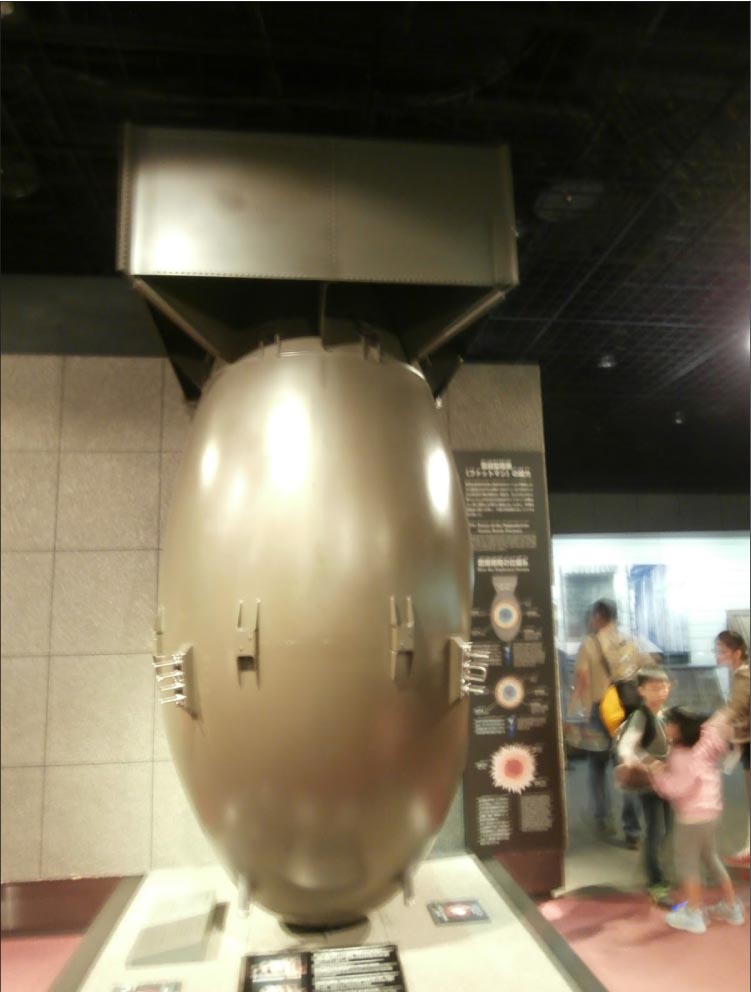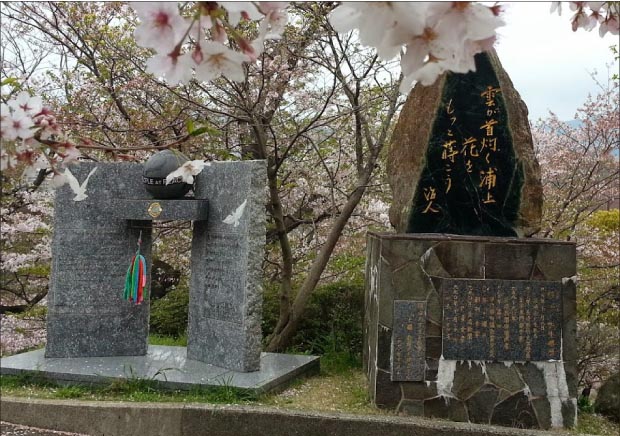The first thing one notices upon entering the exhibit hall are the walls lined with black and white photos of the people of Nagasaki during the Second World War. These pictures depict war efforts that probably happened all around Japan: children doing farm work, women volunteers making care packages and keeping morale up, defense task forces being organized and men being sent off to war.
Midway through the photos, I decided that Nagasaki was quite “normal.” Nothing special struck me about the place. It wasn’t like Kyoto, where there was a rich cultural heritage to protect, nor was it like Tokyo, the capital of Japan. So why was Nagasaki bombed?
At the end of the photo exhibit, dark strains of music can be heard. On a screen to one’s left appears the time and date: August 9, 1945. 11:02 a.m. It quickly shifts to a preview of Nagasaki before it turned into rubble as a large mushroom cloud – the aftermath of an atomic explosion – rose.
As I moved onto the next couple of exhibit halls, I tried to find an answer to why Nagasaki was bombed. There was a timeline showing what I privately dubbed the “life time” of the bomb from its preconception to its last moments.
It apparently started with Leó Szilárd, a Hungarian-American physicist and inventor. In 1939, together with fellow physicist Albert Einstein, Szilárd signed a letter to United States President Franklin D. Roosevelt which discussed the idea of making the atomic bomb. This was to counterbalance Germany’s aggressive research in making an atomic bomb.
Roosevelt’s approval resulted in the Manhattan Project.
In 1945, with the defeat of Nazi Germany and the receding threat of its use of an atomic bomb, Szilárd and 70 other scientists drafted a petition to Roosevelt’s successor, Harry S. Truman, urging an observed demonstration of an atomic bomb’s lethal power before unleashing it on civilians. Unfortunately, the petition never reached Truman. Truman, and to a lesser extent, then-British Prime Minister Sir Winston Churchill, ordered the bombing of two Japanese cities.
I instantly lost a bit of respect for these well-known men in history for their decision. I understood why they did it, but that did not mean that I thought it was morally correct. Yes, I know the bomb was intended to help end the war, but the cost was paid by innocent civilians who had no say during wartime. Through the example of this bomb, the lines of right and wrong are truly blurred in times of war.
Going back to the topic, a long list of cities was written on the timeline. Among them were Kyoto, Osaka, Kokura, Nagasaki, Niigata and Hiroshima. A lot of the cities went on and off the list, but the presence of Hiroshima on that list was quite constant from the very start. It was a port, industrial center, and the site of a major military headquarters.
In the last round of selection, Hiroshima, Nagasaki, Kokura, Kyoto were possible targets for two atomic bombings. Kyoto was dropped from the list because it was considered too culturally important. Nagasaki was taken off the list as well because it was too far.

The first bomb was dropped on Hiroshima, with the second one bound for Kokura. But cloudy weather saved Kokura.
The US Air Force plane then changed course and headed to Nagasaki instead. The bomb was nearly not dropped there as well because of cloudy weather, but it cleared up at the last minute and Nagasaki’s fate was sealed.
Some 60,000 to 80,000 people died as a result. About half the deaths occurred on the first day of bombing. In the following two to four months, large numbers died from the effect of burns, radiation, sickness and other injuries worsened by illness.
Glass bottles and windows melted and became little beads, roof tiles bubbled, coins and rosaries fused together, fallen twisted metal structures resulted from the extremely high temperature and force. Several clocks’ hands in the exhibit starkly showed the time they stopped: 11:02.
The list of ailments caused by the heat and radiation was long, and there was no way to reverse or cure the damage inflicted. Medicine to counter the effects of radiation was not something sold in apothecary shops.
But the greatest damage was the stigma caused by the bomb. Those who did not die a slow painful death or lived alone in their trauma were shunned by fellow countrymen. There really seemed to be no happy ending for Nagasaki’s bomb survivors. (There were filmed testimonials of surviving witnesses shown in the last exhibit hall).
“That was it? Nagasaki got the bomb because Kokura was cloudy?” I asked silently. I thought it was pure chance the city was bombed, that there was no striking information for a concrete reason, that they were unfortunate victims and that was it.
Subsequent research revealed that Nagasaki was a large military port engaged in shipbuilding. It was also generally well-prepared for air raids (warning sirens and safe shelters included) because it was a constant target. But on that fateful day, people ignored the siren, hence, the magnitude of the disaster.
After being even further disillusioned by the choices people made during the war, I decided that involved parties should move towards forgiveness. That’s the best they can do. It would be an understatement to say it is “difficult” to forgive all the collective harmful actions caused by another individual, but forgiveness doesn’t mean “letting them get away with it.”
Rather, forgiveness on my side (the Japanese) is more of accepting what has happened, owning up that Japan had a part in the series of events that led to the bombing, and agreeing to let go of all the anger, bitterness and sorrow.

The youth does not belong to the generation of our grandparents and parents; therefore, we do not need to hold the same grudges as them. We must instead take the lessons and morals that can be learned from the past, apply them to present-day situations, and move on.
Lined up in another part of the museum are thousands and thousands of cranes and signs for world peace. After World War II, origami cranes came to symbolize a hope for peace.
Just outside the museum is a peace park where one can take a walk and enjoy the peaceful surroundings to ease all the tensed sadness felt inside the museum.
Forgiveness is the first step towards peace with others. If only humans can forgive and put down their pride more, then the arms race and war can perhaps be something we can leave in history books. Taking one last look at the cranes, I hoped that people’s prayers for peace can come true. (The author is a Japanese-Tsinoy mestiza and a university student. – Ed.) — First published in Tulay Fortnightly, Chinese-Filipino Digest 27, no. 3 (July 8-21, 2014): 11.




